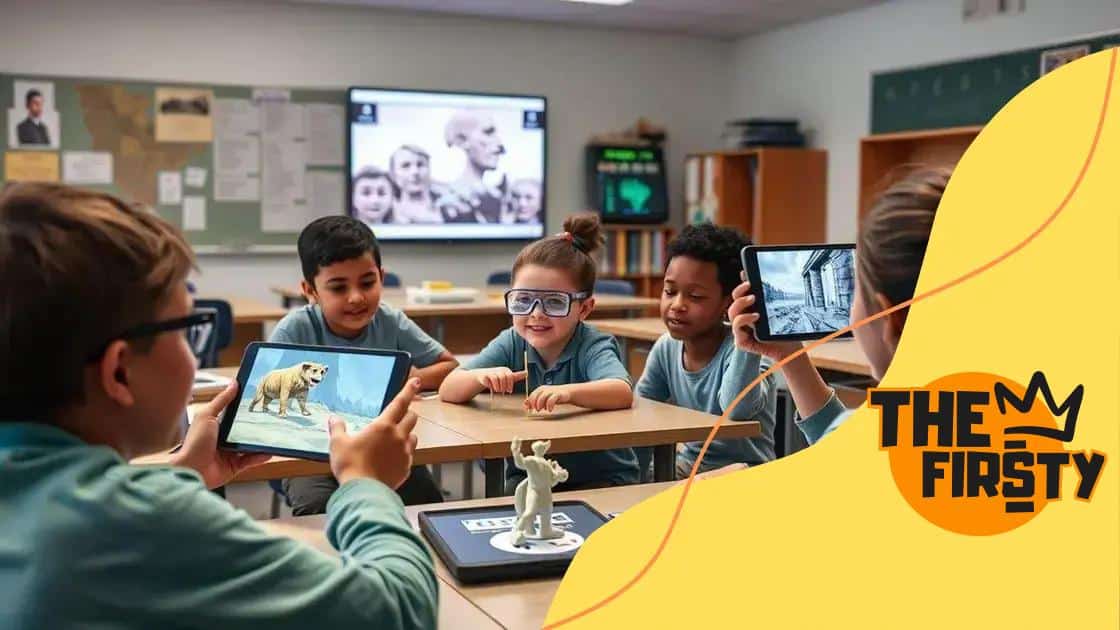The impact of augmented reality on STEM education

Anúncios
The impact of augmented reality on STEM education involves enhancing engagement and understanding through interactive experiences that visualize complex concepts, despite challenges like costs and technical limitations.
The impact of augmented reality on STEM education is reshaping how students engage with complex concepts. Have you ever imagined learning physics by simulating experiments right in your classroom? That’s the power of AR.
Anúncios
Understanding augmented reality in education
Understanding augmented reality (AR) in education is essential for enriching the learning experience. AR merges the digital and physical worlds, transforming how students perceive and interact with information.
One of the key aspects of AR is its ability to create immersive environments. This technology allows learners to visualize complicated concepts, making them easier to understand. For instance, imagine studying anatomy by viewing a life-sized 3D model of the human heart right on your desk!
Key Features of Augmented Reality in Education
AR is not just a tool; it’s a game-changer in how subjects like science, technology, engineering, and mathematics (STEM) are taught. Some fundamental features include:
Anúncios
- Interactivity: Students can manipulate virtual objects, promoting engagement.
- Contextual Learning: Learning experiences are enhanced when students can see information related to their environment.
- Accessibility: AR applications are often available on devices students already use, making them easy to access.
Additionally, AR supports collaborative learning. In a classroom setting, students can work together on interactive projects, sharing insights and ideas as they explore educational content. This cooperative effort can lead to deeper understanding.
Applications of Augmented Reality in Classrooms
Schools worldwide are already implementing AR technologies in various ways:
- Science Labs: Virtual experiments can be conducted without the need for physical materials.
- History Lessons: Students might visit recreated historic sites through AR experiences.
- Mathematics: Visual aids help to explain complex equations or geometric shapes.
The potential of augmented reality in education is limitless. It not only motivates students but also encourages them to become active participants in their learning journey. As AR technology continues to evolve, it promises to play a significant role in shaping the future of education.
Key benefits of augmented reality for STEM
Key benefits of augmented reality for STEM education can significantly enhance the way students learn and interact with complex subjects. This innovative technology opens doors to new methods of teaching, making learning more dynamic and engaging.
One major advantage of AR is its ability to provide immersive experiences. With AR, students can explore intricate concepts in a visually compelling way. For example, envision students observing a solar system simulation where planets orbit in real-time around a sun right on their desks!
Enhanced Engagement
AR can lead to higher levels of engagement. Traditional teaching methods sometimes struggle to captivate students. However, integrating AR into lessons makes learning feel like an adventure. When students actively participate in their learning experiences, they retain information better.
- Interactive Learning: AR allows students to interact with virtual 3D models, enhancing their understanding.
- Motivation: When lessons incorporate technology, students are often more excited and curious.
- Collaboration: AR encourages teamwork as students can work together on projects and experiments.
Another benefit is the accessibility of information. Augmented reality applications are often available on smartphones and tablets. This means that students can use their devices to access learning materials anytime, anywhere.
Real-World Applications
The applications of augmented reality in STEM are wide-ranging and practical. For example, students learning biology can conduct virtual dissections without the need for real specimens. Meanwhile, in chemistry, AR can visualize molecular structures, allowing learners to grasp complex arrangements easily.
- Enhanced Visualization: Difficult concepts become easier to understand through 3D representations.
- Safe Learning Environments: Students can experiment without the fear of accidents.
- Instant Feedback: Interactive AR applications provide real-time assessments and guidance.
Ultimately, the integration of augmented reality into STEM education encourages creativity and innovation. By using AR tools, students are not just passive recipients of knowledge; they actively create their understanding of the world around them.
Real-world applications of AR in classrooms

Real-world applications of augmented reality (AR) in classrooms are transforming how subjects are taught and learned. With the ability to blend digital content with the physical world, AR creates innovative educational experiences that captivate students.
In science classes, AR can bring complex processes to life. For example, students can observe chemical reactions or the anatomy of the body through interactive 3D models. This hands-on approach helps learners visualize and understand difficult concepts more effectively.
Interactive Learning Experiences
AR is not limited to science; it has practical applications across various subjects:
- History: Students can explore historical events by viewing 3D reconstructions of ancient civilizations or famous battles right in their classroom.
- Mathematics: AR can visualize geometric shapes and problems, providing a better understanding of spatial relationships.
- Language Arts: Interactive storybooks with AR features allow students to engage with narratives in a more dynamic way.
Moreover, AR enhances collaboration among students. They can work together on AR projects, sharing insights and problem-solving in a group. This collaborative approach fosters critical thinking and improves social skills.
Examples of AR in Action
Many schools worldwide are already incorporating AR into their curriculum:
- Virtual Field Trips: Students can visit places like the Great Wall of China or Mars without leaving their classroom, making learning exciting and accessible.
- 3D Models: Lessons in biology can include virtual dissections or simulations of ecosystems.
- Interactive Simulations: Physics concepts, like force and motion, can be demonstrated through AR simulations that allow students to experiment in real-time.
As educators integrate augmented reality into their teaching methods, they help students connect theoretical concepts with practical understanding. This technology not only enhances engagement but also prepares learners for a future where such tools will be commonplace in various fields.
Challenges of integrating AR into STEM education
Challenges of integrating augmented reality (AR) into STEM education are important to consider. While AR offers exciting possibilities, there are obstacles that schools and educators face when implementing this technology.
One significant challenge is the cost of AR tools and resources. Not all schools have the budget to purchase high-quality AR software or devices. This can limit the ability of educators to provide engaging learning experiences using AR.
Technical Limitations
Another hurdle lies in the technical limitations of AR technology. Students and teachers may experience issues with connectivity and device compatibility. Furthermore, not all AR applications are user-friendly, which can hinder effective use in the classroom.
- Device Availability: Students often use personal devices, which may not support AR applications smoothly.
- Software Issues: Frequent app updates or crashes can disrupt lessons and learning.
- Training Needs: Teachers may require more training to use AR technology effectively.
Moreover, integrating AR requires thoughtful curriculum planning. Educators must design lessons that meaningfully incorporate AR rather than using it as a novelty. This alignment can be challenging, as teachers need to ensure that AR activities meet learning objectives.
Resistance to Change
There may also be resistance from educators and administration when it comes to adopting new technologies. Some teachers are accustomed to traditional teaching methods and may feel uncertain about using AR tools in their classrooms. This skepticism can slow down the adoption process.
- Time Constraints: Finding time to plan and implement AR lessons can be challenging amidst existing curriculum requirements.
- Support Availability: Schools may lack the technical support necessary for troubleshooting AR issues.
- Parental Concerns: Parents might worry about the screen time associated with new technology.
Despite these challenges, the potential benefits of augmented reality make it worth addressing these obstacles. Schools that successfully integrate AR can create dynamic learning environments that better engage students in STEM topics.
Future trends of AR in educational settings
Future trends of augmented reality (AR) in educational settings are promising and exciting. As technology evolves, AR is expected to play an even bigger role in how students learn and interact with information.
One key trend is the integration of AR with artificial intelligence (AI). This combination can create personalized learning experiences for students. For instance, AI algorithms can analyze how students interact with AR content and provide tailored lessons based on individual needs.
Enhanced Collaboration Tools
Another growing trend is the development of collaborative AR platforms. These platforms will allow multiple users to interact with the same AR content simultaneously. Students can work together on projects from different locations, enhancing teamwork and communication skills.
- Virtual Classrooms: Students around the world can join AR classrooms, regardless of their physical location.
- Global Learning Communities: Learners can collaborate on projects with peers from different cultures, broadening their perspectives.
- Real-Time Feedback: Immediate responses to student actions can guide their learning process.
Moreover, we can expect AR applications to become more streamlined and user-friendly. As developers focus on improving interface design, teachers and students will find it easier to navigate these tools. This change can lead to increased adoption in classrooms.
Incorporation of Virtual Reality Elements
Additionally, the lines between augmented reality and virtual reality (VR) may blur. Future educational tools might integrate both technologies to create fully immersive learning experiences. For example, students could use AR to visualize a concept and then transition into a VR environment to explore it further.
- Engaging Learning Environments: Immersive experiences can enhance student motivation and interest.
- Hands-On Learning: Students can engage in simulations that mimic real-world scenarios.
- Experiential Learning: New teaching methods can provide students with practical experience in their fields of study.
Overall, the future of augmented reality in education looks bright. As these trends develop, they promise to enrich the learning landscape, making education more engaging, accessible, and effective for students everywhere.
augmented reality is transforming the way we approach education, especially in STEM subjects. This technology enhances engagement, promotes interactive learning, and makes complex concepts easier to grasp. While there are challenges to integrating AR into classrooms, the benefits far outweigh them. As we look forward to the future trends of AR, we can expect even more innovative applications that will reshape learning experiences and prepare students for the future.
FAQ – Frequently Asked Questions about Augmented Reality in Education
What is augmented reality and how is it used in education?
Augmented reality (AR) is a technology that overlays digital information onto the real world. In education, it is used to create interactive learning experiences, making complex concepts easier to understand.
What are the benefits of using AR in STEM education?
AR enhances engagement, promotes interactive learning, and allows students to visualize challenging subjects in a more accessible way.
What challenges do schools face when integrating AR?
Schools may encounter challenges such as high costs, technical limitations, lack of training for teachers, and resistance to adopting new technology.
What future trends can we expect for AR in educational settings?
Future trends include integrating AR with artificial intelligence for personalized learning, enhanced collaboration tools, and the incorporation of both AR and virtual reality for immersive educational experiences.





